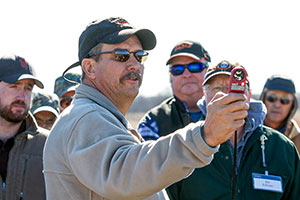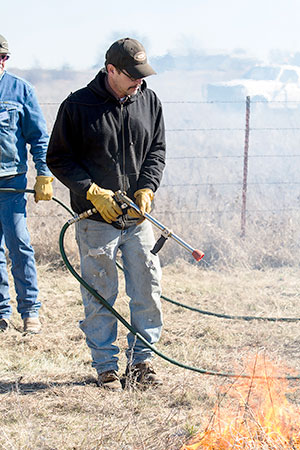Farmers, Landowners Study-Up at Prescribed Burn Workshop

The Samuel Roberts Noble Foundation in partnership with the Oklahoma Prescribed Burn Association (OPBA), Oklahoma State University Extension, and Natural Resource Conservation Service (NRCS) hosted a prescribed burn workshop on January 15 and 16, 2014 at the Noble Foundation’s Oswalt Road Ranch in Marietta, Oklahoma to educate local farmers, ranchers, and landowners on how to conduct safe and effective prescribed burns on their land.
The event drew over 40 agricultural producers from as far away as New Mexico and walked participants through everything from the basic reasons for prescribed fire, to designing a burn plan, and even burning a practice acre in the field.
Pitching the positive aspects of prescribed fire, Russell Stevens, Noble Foundation wildlife and fisheries consultant, emphasized “fire is natural” and “prescribed fire is not wildfire.” He explained that fire is essential to healthy plant and wildlife communities, and that prescribed fire helps mitigate the effects of catastrophic wildfires by reducing the fuel available for burning.

What is a prescribed burn?
Fire is fire, right? No. The distinction between a prescribed fire and wildfire is significant. Wildfire is completely out of control, whether it was started by a careless individual or is a natural occurrence. By contrast, prescribed fire is just one of an entire suite of land management practices that might be used to achieve any number of outcomes, such as reduction of invasive plant species or improvement of ground fowl habitat.
A prescribed fire may be planned months, or even a year in advance, and is designed for a specific purpose. That’s why burn experts like Russell Stevens and John Weir, OSU Natural Resource Ecology and Management research associate, even like to draw a distinction between prescribed burn and controlled burn. While in many cases the two terms can be used interchangeably, the suggestion that fire can be “controlled” is a misnomer, and “managed” burn may be a more accurate term.
Safety first
As the workshop attendees learned, there’s a lot of work that goes into planning a prescribed burn, from alerting neighbors and authorities, to identifying exactly how, when, and where a fire will be ignited. Wind, temperature, humidity, type of fuel to be burned (grass, shrubbery, trees, etc.) are all variables that need to be considered before a burn can happen.

The often erratic nature of fire led to the decision of workshop facilitators to forego the highlight of the event: a fifty acre burn that would allow participants to apply everything they had learned over two days. The burn, which Weir had been planning for months, required north or northwesterly winds because of a highway to the north and a family to the west that would otherwise be inundated with smoke. Additionally, the humidity (amount of water vapor in the air) needed to be 40 percent or higher.
Weir explained that while many associate summer with dry air, Oklahoma winters are much dryer. “Transpiration [the process of water evaporation from plants] in the summer can lead to 100 percent humidity on Oklahoma mornings,” Weir said.
The less variance there is between high and low temperatures, the higher the humidity is likely to be. Large swings in temperature, such as those we experience in winter from the low 60s to the high 20s, are what lead to dry air. That’s why burning trash piles in the winter can turn into such a dangerous situation.
Get involved!
“I wouldn’t ever do a burn on my own place until I did a few burns with people I know are experienced,” said Michael Porter, Noble Foundation senior wildlife and fisheries consultant.
Doing a prescribed burn right can take a lot of time and energy—for several months of planning, the fire may only last a few hours—but the rewards in farm and ranch productivity, health of natural areas, and increased safety from wildfire are well worth it. Safety is always the most critical concern, so working with a local prescribed burn association and attending workshops like those provided by the Noble Foundation are a great place to start.
Learn more!
Free online prescribed fire training
Oklahoma State University Documents on Prescribed Fire:
Oklahoma Prescribed Burn Handbook
The Best Time of Year to Conduct Prescribed Burns
Burn Plan For Prescribed Burning
Firebreaks for Prescribed Burning
Fire Effects in Native Plant Communities
Documents on Cedar and Cedar Control:
Cedar Control by Individual Scorched-tree Ignition
How Eastern Redcedar Encroachment Affects the Water Cycle of Oklahoma Rangelands
More Prescribed Fire Stories:
Prescribed Burn Associations Receive New Radios
Summer Burn Workshop Highlighted by Prescribed Fire
